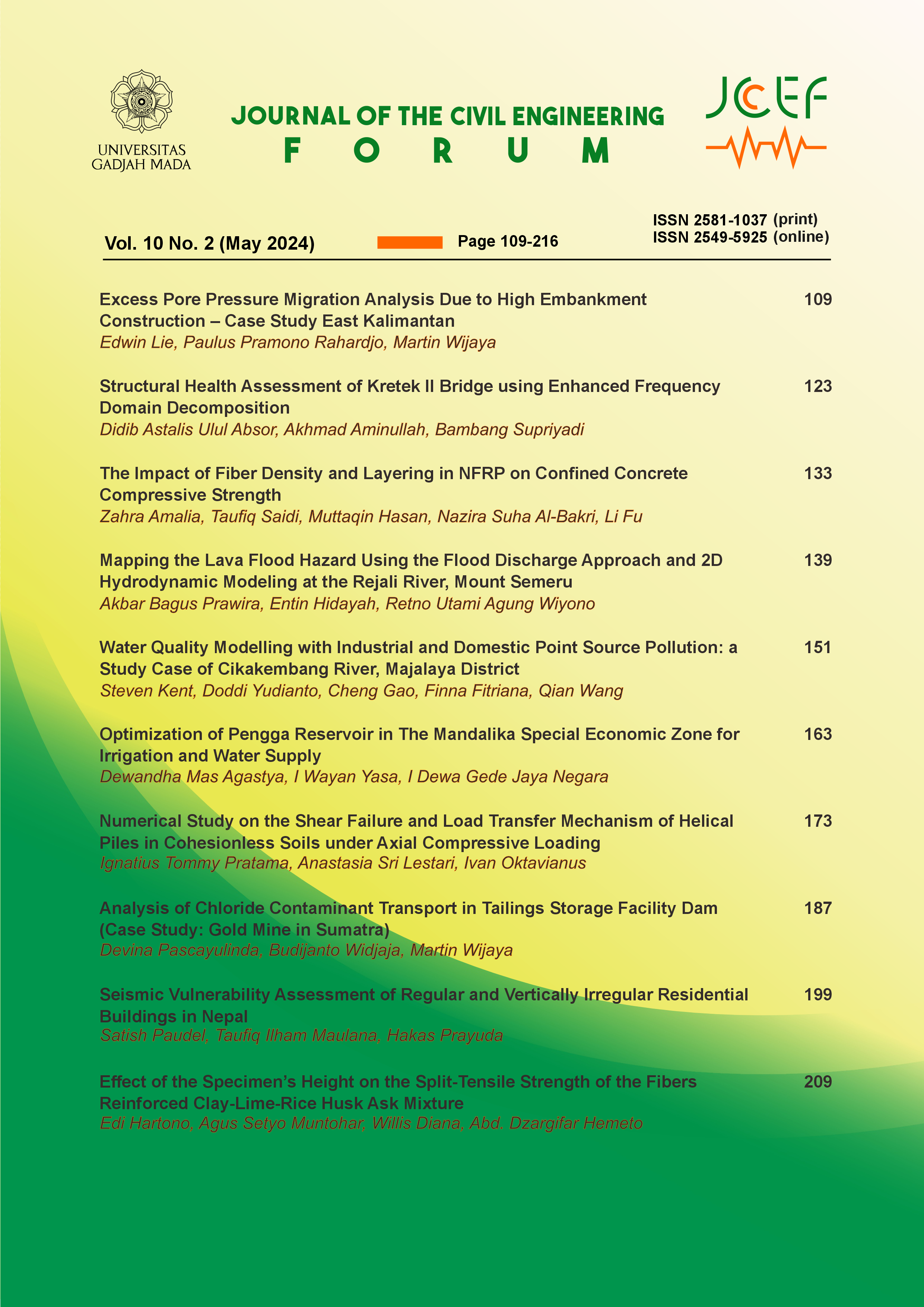Excess Pore Pressure Migration Analysis Due to High Embankment Construction – Case Study East Kalimantan
Abstract
A 42-inch pipeline traverses a predominantly flat right-of-way (ROW), running from south to north in East Kalimantan. Adjacent to the ROW, a coal mine concession was located on the western side, while the Mahakam River lies a further 3 km to the east. A mining waste dump has been constructed since 2010, situated in an area underlain by soft alluvium soil (Qa). The waste was stacked, reaching heights of up to 75 meters, with its toe approximately 200 m from the edge of the ROW. In 2016, a failure occurred in the ROW, causing the 42-inch pipeline to shift a maximum of 6.8 m horizontally, and rise by 2.0 m within a 300 m span. A geotechnical investigation was then conducted, consisting of 7 CPTu with dissipation testing. The CPTu results indicated high pore pressure, with a layer of soft clay ranging from 15 to 32 m thickness found in the ROW area. A hypothesis was formulated suggesting that the soft clay was not fully consolidated. Hence, the failure of the pipeline was possibly caused by the migration of excess pore water pressure accumulated during the construction of the waste dump. Results of the investigation indicated that the permeability coefficient was 2.5 times greater in the horizontal direction compared to the vertical ones (kh/kv = 2.5), allowing the pore water pressure to migrate more easily in the horizontal direction. This study aims to elucidate how the migration of excess pore water pressure in the horizontal direction influences ground stability. The analysis was conducted using finite element software MIDAS GTS NX, with the kh/kv varying from 2.5 to 100 times to explore excess pore pressure movement behaviors. The results of this study confirm that excess pore pressure migration can occur horizontally if the horizontal permeability coefficient is larger than its vertical counterpart. Thus, this study highlights that the greater the permeability coefficient and the larger the ratio, the further the excess pore pressure travels. Moreover, the horizontal displacement increases with the permeability coefficient ratio.
References
Al-Khazaali,M.andVanapalli,S. K.(2018) ‘Axial force displacement behaviour of a buried pipeline in saturated and unsaturated sand’, Géotechnique pp. 1–66. URL: https://doi.org/10.1680/jgeot.17.p.116
Balachowski,L.(2006),‘Soft soil over consolidation and CPTu dissipation test’, Hydro-Engineering and Environmental Mechanics 53(2), 155–180.
Chai, J., Sheng, D., Carter, J. and Zhu, H. (2012), ‘Coefficient of consolidation from non-standard piezocone dissipation curves’, Computers and Geotechnics 41, 13–22. URL: https://doi.org/10.1016/j.compgeo.2011.11.005
Chung, S., Kweon, H. and Jang, W. (2014), ‘Hyperbolic fit method for interpretation of piezocone dissipation tests’, Journal Geotechnical and Geoenvironmental Engineering 140(1), 251–254. URL: https://doi.org/10.1061/(ASCE)/GT.19435606.0000967
Lim,B.,Tumay,M.,Lee,J.,Jun,B.and Jung,J.(2014),‘A case study in evaluating the status of consolidation of a soft soil deposit by incomplete piezocone dissipation tests using laboratory and field data’, Soils and Foundations 54(4), 648–656. URL: https://doi.org/10.1016/j.sandf.2014.06.007
Liu, S., Ju, J., Cai, G. and Liu, Z. (2014), ‘Stress history estimation method of underconsolidated soil by partial piezocone dissipation tests’, Marine Georesources & Geotechnology 32, 368–378. URL: https://doi.org/10.1080/1064119X.2013.778376
Melnikov, e. a. (2016), ‘OCR and POP parameters in plaxis-based numerical analysis of loaded over consolidated soils’, Procedia Engineering 165, 845–852. URL: https://doi.org/10.1016/j.proeng.2016.11.783
Robertson,P.(2010),Estimating in-situ soil permeability from CPT & CPTu, in ‘2nd International Symposium on CPT’.
Shen, N., Qi, X., Shen, L., Li, B. and Yan, Y. (2009), Geological hazard assessment in the construction site of lng pipeline project, in ‘American Society of Civil Engineers International Conference on Pipelines and Trenchless Technology (ICPTT) 2009- Shanghai, China’, pp. 1532–1541. URL: https://doi.org/10.1061/41073(361)161
Sully, J., Robertson, P., Campanella, R. and Woeller, D. (1999), ‘An approach toevaluationof field CTPu dissipation data in overconsolidated fine-grained soils’, Journal of Canadian Geotech 36, 369–381.
Teh, C. and Houlsby, G. (1991), ‘An analytical study of cone penetration test in clay’, Geotechnique 41(1), 17–34. URL: https://doi.org/10.1680/geot.1991.41.1.17
Terzaghi,K.,Peck,R.and Mesri,G.(1996),Soil Mechanics in Engineering Practice, 3rd edn, John Wiley & Sons, NewYork.
Trautmann, C. H. and O’Rourke, T. D. (1985), ‘Lateral force-displacement response of buried pipe’, Journal of Geotechnical Engineering 111(9), 1077–1092. URL: https://doi.org/10.1061/(ASCE)07339410(1985)111:9(1077)
Visnuvardhan,S.,Murthy,A.and Choudhary,A.(2023), ‘A review on pipeline failures, defects in pipelines and their assessment and fatigue life prediction methods’, International Journal of Pressure Vessels and Piping 201. URL: https://doi.org/10.1016/j.ijpvp.2022.104853
Whittle, A., Sutabutr, T., Germaine, J. and Varney, A. (2001), ‘Prediction and interpretation of pore pressure dissipation for a tapered piezoprobe’,Geotechnique 51(7), 601–617. URL: https://doi.org/10.1680/geot.2001.51.7.601
Yuan, F., Li, L. and Guo, Z. (2014), Numerical study of landslide impact on submarine pipelines, in ‘Proceedings of the ASME 2014 33rd International Conference on Ocean, Offshore and Arctic Engineering OMAE2014’,San Francisco,USA.
Zhang, W. Y. and Askarinejad, A. (2021), ‘Ultimate lateral pressures exerted on buried pipelines by the initiation of submarine landslides’, Landslides 18, 3337–3351. URL: https://doi.org/10.1007/s10346-021-01711-8
Zhang,Y.et al.(2022),‘Pore pressure response and dissipation of piezocone test in shallow silty soil of yellow river delta’, Journal of Marine Science and Engineering 10(2), 255. URL: https://doi.org/10.3390/jmse10020255
Copyright (c) 2024 The Author(s)

This work is licensed under a Creative Commons Attribution-ShareAlike 4.0 International License.
Copyright is granted to authors for the purpose of providing protection for articles written to describe experiments and their results. JCEF will protect and defend the work and reputation of the author and are also willing to address any allegations of violation, plagiarism, fraud, etc. against articles written and published by JCEF. JCEF is published under the terms of the Creative Commons Attribution-ShareAlike 4.0 International License (CC BY-SA 4.0). The author holds the copyright and assigns the journal rights to the first publication (online and print) of the work simultaneously.







